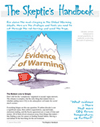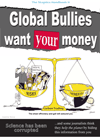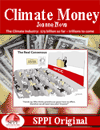|
|
Australia (orange line second from the bottom) has a lower energy intensity of use than many countries (see below for more information). On this graph. Japan is the lowest. The world average is the dark purple line. China is so high it is off the scale.
It’s part of the spin game that almost every statistic is spun-into-oblivion, and here, thanks to Mike Wilson, is the analysis of why “per capita” statistics are meaningless.
Ross Garnaut (and dozens of others) claim Australia has a high emissions intensity of energy use. Yet Mike Wilson shows below that Australia’s energy intensity is not just declining, it’s below the world average, and below Canada, South Africa, China and the US.
The Garnaut Review:
“Relative to other OECD countries, Australia’s high emissions are mainly the result of the high emissions intensity of energy use, rather than the high energy intensity of the economy or exceptionally high per capita income. Transport emissions are not dissimilar to those of other developed countries. Australia’s per capita agricultural emissions are among the highest in the world, especially because of the large numbers of sheep and cattle.
The high emissions intensity of energy […]
I can hardly let the demise of the Chicago Climate Exchange go by without a note.
Didn’t I point out that if carbon trading was a free market, nobody would pay a cent?
Well, hail the triumph of the free market.
(Yes, a couple of weeks back, when the news came out that the CCX was closing, it did make my day.)
But as Steven Milloy points out the death of the US national carbon market has barely made a mention in the news.
How did the Green press react? Denial:
“[There are] no implications for the EU and UK,” Emilie Mazzacurati, head of carbon research for North America at Point Carbon, told BusinessGreen in an email.
No implications? None? And would they have said that if new markets had blossomed in, say, Japan or Brazil?
The market opened in Nov 2000, and as Milloy notes, with a red carpet future:
The CCX was the brainchild of Northwestern University business professor Richard Sandor, who used $1.1 million in grants from the Chicago-based left-wing Joyce Foundation to launch the CCX. For his efforts, Time named […]
Carbon credits: Just another excuse to "print money"
… If this was Exxon pushing a PDF promoting skeptical views, it would be on the front page tomorrow. Where are the front page headlines?
“Bankers feed scare-mongering report”
Instead it’s just Deutsche Bank try to save the world their profit line.
Just in case you are missing your daily dose of being spoon fed propaganda by Bankers who want your money, see Climate Spectator Balancing reason and risk, where Deutsche Bank is helping the skeptics by giving us yet another example of just how desperate they are to get carbon trading running.
Q: When will the bankers worry about whales?
(Ans: When they can trade Humpback Credits.)
The good news is we are getting to them, and we are marking the lines they need to jump over. They now admit it looks bad when they denigrate scientists (they finally “get” that they shouldn’t call scientists deniers):
Although the scientific community has already addressed the sceptic arguments in some detail, there is still a public perception that scientists have been dismissive of the sceptic viewpoint,
Watch how they pretend to care about the science (science-schmaltz), […]
What a surprise: The free-market-that-is-not-free leaps from one scandal to the next. In a real free market where salesmen sell something real, and buyers buy something they want, people can’t get away with cheating, or not for long.
If someone sold you a bulk carrier of coal, and it turned up empty, you’d notice.
10 out of 10 based on 3 ratings […]
For the last five years the carbon market has been doubling year after year. But in 2009, the exponential growth trajectory paused. Point Carbon issued a report this week estimating that the world wide market in carbon trading in 2009 totalled around $136 billion dollars, which is not much higher than the 2008 figure. After years of living in a rapacious bubble, prices are about 60% below the peaks of 2008, carbon traders are starting to peel out into other commodities, and the sails are looking decidedly flat on the Maxi Yacht known as Carbon-Credits Inc.
The size of the market in gigatons of carbon grew nearly 70% over 2008, but the falling prices meant the same amount of money churned through the system and the total dollars were very similar year on year.
How times have changed. Back in May 2009, emissions traders were feeling confident that a US market for emissions would be approved. Not surprisingly, the low carbon prices and the non-event of Copenhagen mean that carbon traders are becoming frustrated. Some are even expanding into… markets that are based on real commodities like oil, gas, gold and steel. [Reuters]
10 out […]
NEWS: PROTEST IN CANBERRA Mon 4th (see below)
It’s Day 43 without food, and Peter Spencer grows weaker. For those who don’t know, Peter Spencer’s farm has been stolen from him by our government through Native Vegetation Legislation — which locked up 80 – 90% of his entire farm but paid him no compensation. The regrowth on his farm holds “carbon credits” of supposed value to the Commonwealth, yet Peter has been obliged by law to pay the rates on that land-that-holds-these-carbon-credits, and the mortgage for the right to do nothing with this land that really belongs to the Commonwealth. Is this not an extortionate tax?
Prime Minister Kevin Rudd has declined all requests to meet Peter.
In a grand failure of journalism, our largest dailies apparently think angry tweeting travelers is more important than that a $10 billion dollars crime, and a life in the balance.
Peter Spencer tried ingenious means to work within the rules. But he has been driven into bankruptcy. The 200 days he spent in court, with all costs associated with just trying to have his case heard, added to the burden. (200 days!) After there was no other route left open to […]
There are people out there who manufacture money from nothing. Literally. The rest of the world has to earn it, but some are in it from the start–where money is created from the ether.
Banking is not a secret but no one tells you how it works… it’s hard to get your head around it, but if everyone understood, some aspects would be outlawed tomorrow (just like they used to be).
Greens and bankers make strange bedfellows. The bankers know where the Greens are coming from, but the Greens need to find out why bankers, “the paper aristocracy”, are so keen to save the planet. It’s an unholy alliance.
10 out of 10 based on 2 ratings […]
Another major carbon auditor goes down.
Norways’ DNV (Det Norse Veritas, “The Norwegian Truth”) was the largest auditor of the infamous CDMs (Clean Development Mechanisms) until it was suspended last December when it was caught selling carbon credits for projects it hadn’t checked. At the time it was so large it had approved fully half of all CDM credits on the market. Its excess workload was transferred to number two auditor, SGS, and shock, this week, SGS has been caught and suspended because it couldn’t prove it’s staff had properly vetted projects either. Indeed it couldn’t show that they were even trained to do that vetting. (Did SGS not see this coming?)
When the West offered money to buy the rights to air-with-slightly-less-carbon-dioxide-than-it-could-have-had, China and India put up their hands and said “Yes please” 900 times. And why wouldn’t they? CDMs are worth about 20% of all emissions trades, which amounted to $126 billion in 2008. Up until the global financial crisis it was doubling annually, like all good ponzi schemes do.
10 out of 10 based on 2 ratings […]
Climate Money is poised to rocket—creating even larger pools of vested interests. Once it starts, how could we unwind trillions of trading rights?
Say hello to the real new force in climate science—banks.
The Shadow of Stratospheric Climate Money. Far north South Australia, Aug 2009.
First Up. Governments Up the Ante.
In the 2008-2009 financial year, Bush threw billions on the table with financial rescues and tax credits, only to be wildly outdone by Obama.
The new funding provisions made since the financial emergency of Sept 2008 are not included in the previous table of climate funds that amounted to $79 billion (so far). It’s difficult to assign the rescue package figures into strict financial years—yet the new numbers are titanic, and step right out of the scales drawn on the past funding graphs.
10 out of 10 based on 8 ratings […]
Carbon credits are a form of fiat currency, yet as calls for carbon trading grow, ironically, another fiat currency collapses—destroying life savings, wiping out jobs, and taking down historic institutions overnight. […]
|
JoNova A science presenter, writer, speaker & former TV host; author of The Skeptic's Handbook (over 200,000 copies distributed & available in 15 languages).

Jo appreciates your support to help her keep doing what she does. This blog is funded by donations. Thanks!


 Follow Jo's Tweets
Follow Jo's Tweets To report "lost" comments or defamatory and offensive remarks, email the moderators at: support.jonova AT proton.me
Statistics
The nerds have the numbers on precious metals investments on the ASX
|












Recent Comments